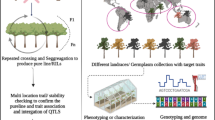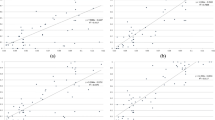Abstract
Recent work and publications in human population genetics involving very dense SNP datasets suggest that the use of these markers will become common in plant breeding. The experience of human geneticists futher suggests that attention will need to be paid to the very high degree of genomic heterogeneity of population genetic measures such as genetic diversity. Dense marker sets will also allow more precision of estimates of relatedness between individual plants or pure-breeding lines.





Similar content being viewed by others
Literature Cited
Akey JM, Eberle MA, Rieder MJ, Carlson CS, Shriver MD, Nickerson DA, Kruglyak L (2004) Population history and natural selection shape patterns of genetic variation in 132 genes. PLoS Biology 2:1591–1599
Ayres KL, Overall ADJ (1999) Allowing for within-subpopulation inbreeding in forensic match probabilities. Forensic Sci Int 103:207–216
Bersaglieri T, Sabeti PC, Patterson N, Vanderploeg T, Schaffner SE, Drake JA, Rhodes M, Reich DE, Hirschhorn JN (2004) Genetic signatures of strong recent positive selection at the lactase gene. Am J Hum Genet 74:1111–1120
Buckler ES IV, Thornsberry JM, Kresovich S (2001) Molecular diversity, structure and domestication of grasses. Genet Res 77:213–218
Curie-Cohen M (1982) Estimates of inbreeding in a natural population: a comparison of sampling properties. Genetics 100:339–358
Daly MJ, Rioux JD, Schaffner SF, Hudson TJ, Lander ES (2001) High-resolution haplotype structure in the human genome. Nat Genet 29:229–232
Evett IW, Weir BS (1998) Interpreting DNA Evidence. Sinauer Associates, Sunderland, MA
Hepler AB (2005) Improving forensic identification using Bayesian networks and relatedness estimation. Ph.D. Thesis, North Carolina State University, Raleigh, NC
Hinds DA, Stuve LL, Nilsen GB, Halperin E, Eskin E, Ballinger DG, Frazer KA, Cox DR (2005) Whole-genome patterns of common DNA variation in three human populations. Science 307:1072–1079
International HapMap Consortium (2003) The International HapMap project. Nature 426:789–796
International HapMap Consortium (2005) A haplotype map of the human genome. Nature 437:1299–1320
Ke XY, Hunt S, Tapper W, Lawrence R, Stavrides G, Ghori J, Whittaker P, Collins A, Morris AP, Bently D, Cardon LR, Deloukas P (2004) The impact of SNP density on fine-scale patterns of linkage disequilibrium. Hum Mol Genet 13:577–588
McVean G, Awadalla P, Fearnhead P (2002) A coalescent-based method for detecting and estimating recombination from gene sequences. Genetics 160:1231–1241
Milligan BG (2003) Maximum-likelihood estimation of relatedness. Genetics 163:1153–1167
Ordon F, Ahlemeyer J, Werner K, Köhler W, Friedt W (2005) Molecular assessment of genetic diversity in winter barley and its use in breeding. Euphytica 146:21–28
Palsson A, Rouse A, Riley-Berger R, Dworkin I, Gibson G (2004) Nucleotide variation in the Egfr locus of Drosophila melanogaster. Genetics 167:1199–1212
Weir BS (1979) Inferences about linkage disequilibrium. Biometrics 35:235–254
Weir BS (1996) Genetic Data Analysis II. Sinauer Associates, Sunderland MA
Weir BS (2003) Forensics. In: Balding DJ, Bishop M, Cannings C (eds) Handbook Stat Genet. Wiley, New York, pp 830–852
Weir BS, Cockerham CC (1984) Estimating F-statistics for the analysis of population structure. Evolution 38:1358–1370
Weir BS, Cardon LR, Anderson AD, Nielsen DM, Hill WG (2005) Measures of human population structure show heterogeneity among genomic regions. Genome Res 15:1468–1476
Weir BS, Hill WG (2002) Estimating F-statistics. Annu Rev Genet 36:721–750
Weir BS, Hill WG, Cardon LR (2004) Allelic association patterns for a dense SNP map. Genet Epidemiol 27:442–450
Yoon CK (1993) Botanical witness for the prosecution. Science 260:894–895
Author information
Authors and Affiliations
Corresponding author
Rights and permissions
About this article
Cite this article
Weir, B.S. Impact of dense genetic marker maps on plant population genetic studies. Euphytica 154, 355–364 (2007). https://doi.org/10.1007/s10681-006-9283-4
Received:
Accepted:
Published:
Issue Date:
DOI: https://doi.org/10.1007/s10681-006-9283-4




